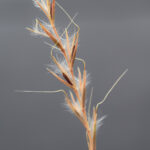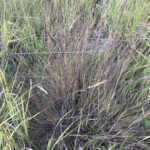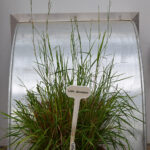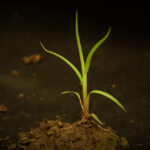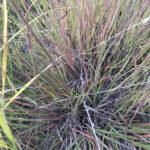Little Bluestem
Schizachyrium scoparium
General Description
Little bluestem is a native warm season perennial bunchgrass. It has stiff stems that turn bronze/reddish when plants are at late maturity. The stems will stay standing for multiple years if not harvested. The basal leaves (to 15 cm long) are folded, and light green to blue-green in colour. Little bluestem has the ability to spread outwards through its short rhizomes, potentially forming a small mat. Seed heads are feathery and white with short awns. While little bluestem is found throughout the prairies, it makes up a greater composition of native prairie stands in the eastern mixed grass prairie and the tall grass prairie.
Type
Native grass.
Origin
Native to eastern Mixed Grass Prairie and Tall Grass Prairie of Saskatchewan and Manitoba.
Longevity
At least 5 years (seeded). Can be long-lived in native stands.
Use
Reclamation, pasture.
Optimal Time of Use
Summer, fall. Little bluestem is a warm season grass and does not initiate growth until summer. Optimally used mid-summer and early fall.
Recovery After Use
Little bluestem should be grazed once per year to ensure stand longevity. Leave at least four inches (100 mm) of plant growth after grazing to enhance winter hardiness.
Palatability/Nutritional Value
Little bluestem is palatable, however palatability decreases drastically once stems and seed heads emerge. While crude protein is good early in the summer (15%) it can drop to less than 4% by later summer/early fall. When old, stiff stems accumulate they will have lower quality and will actually deter livestock use.
Annual Precipitation min/max (mm)
305mm / 1140mm
Drought Tolerance
Good tolerance.
Flooding Tolerance
Little bluestem will withstand saturated soils for approximately one week in the spring.
Winter Hardiness
Good hardiness.
Soil Texture Preference
Little bluestem is adapted to upland soils with shallow water tables (including sub-irrigated) or areas where snow is trapped over winter. It is suited to sandy and rocky through clay soils.
Erosion Control
Little bluestem is not considered for erosion control, though it is slightly rhizomatous. Little bluestem can contribute to a diverse reclamation mix as it is suited to a wide range of soils including thin and gravelly sites.
Salinity Tolerance
Low tolerance.
Acidity Tolerance
Moderate tolerance. Little bluestem tolerates soil pH as low as 5.5.
Alkalinity Tolerance
Low to moderate tolerance.
Seeds per kg
529,000 seeds/kg (240,000 seeds/lb)
Suggested Mixtures
Plant with adapted warm and cool season native species for reclamation and grazing.
Ease of Establishment
Little bluestem seedlings have low vigor. Good weed control is needed for establishment. Some self-seeding can occur. Seeds are light and fluffy which can cause bridging issues in seed drills, making product feeding challenging.
Competitiveness
Little bluestem is not a strong competitor with highly productive cool season grasses as it starts to grow when these grasses are at peak production.
Management Considerations
Provide adequate rest following grazing to little bluestem stands. Little bluestem initiates growth later in the season so allow for adequate plant growth before grazing the stand (minimum 3-leaf stage). Alternatively, in moister regions, early grazing of a mixed stand, prior to growth initiation of little bluestem, may enhance the productivity of this warm season grass by removing early season competition and warming the soil. Success in keeping little bluestem in long-term mixed stands in drier regions of mixed grass prairie has been poor.
Saskatchewan Dryland Forage Species Adaptation Tool, AAFC Field Guide to Selected Native Forages, USDA Plants Database, Manitoba Forage Adaptation and Comparison Guide
